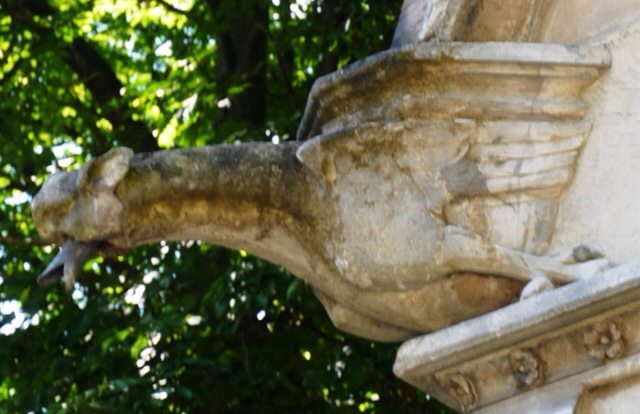Gargoyles, sometimes called grotesques, are thought to date back to the 12th century. You will find them all over Europe on Gothic buildings as a means of directing water away from the building – water spouts. During the Middle Ages gargoyles became the popular form of these water spouts as I have shown in my previous post on Notre Dame Paris. The ones shown above are apparently “just for fun” and have at least three explanations. The stone masons were bored and looking for things to do, they are there to ward off evil and/or they were set on the churches to encourage pagans (who often believed in animal gods) to join the church. Gargoyles were used as a representation of evil. It is also thought that they were used to scare people into coming to church, reminding them that the end of days is near. It is thought that their presence symbolically assured congregants that evil is kept outside of the church’s walls.
In terms of the water spouts, the builders found them useful to get water away from the building but the soft stone would begin to wear, requiring replacement. Some began to use lead, which was more durable. In modern times, they began to use pipe, you can see the pipe protruding from the one to the left from Notre Dame Paris. Gargoyles are usually an elongated fantastic animal because the length of the gargoyle determines how far water is thrown from the wall. The ancient Egyptians, Greeks, Etruscans and Romans all used animal-shaped waterspouts. Lion gargoyles were popular with the ancient Greeks and were used on houses in Pompeii during Roman times.
A French legend that sprang up around the name of St. Romanus (“Romain”) (AD 631–641), the former chancellor of the Merovingian king Clotaire II who was made bishop of Rouen, relates how he delivered the country around Rouen from a monster called Gargouille or Goji. La Gargouille is said to have been the typical dragon with batlike wings, a long neck, and the ability to breathe fire from its mouth. (like the one to the right from Roen). There are multiple versions of the story, either that St. Romanus subdued the creature with a crucifix, or he captured the creature with the help of the only volunteer, a condemned man. In each, the monster is lead back to Rouen and burned, but its head and neck would not, due to being tempered by its own fire breath. The head was then mounted on the walls of the newly built church to scare off evil spirits, and used for protection. In commemoration of St. Romain the Archbishops of Rouen were granted the right to set a prisoner free on the day that the reliquary of the saint was carried in procession.
There are a lot of gargoyles on the Palace of Justice in Rouen, which is basically the local courthouse (any thoughts on who the lawyers wanted to scare away, maybe unhappy patrons). These are the variety that don’t really do anything, just provide for amusing and unusual close up viewing.
Roulland Le Roux (1508-1527) was the French gothic architect responsible for the construction of the Roen Palace of Justice, built between 1499 and 1508. in is one of the few civil gothic buildings in the late renaissance.
Here are some more gargoyles from the Palace of Justice in Rouen, you can see damage from bullets and shelling from WWII, restorations are ongoing.
Here is one from the tomb of Héloïse and Abélard (1164) at Pere Lachaise with lead pipe in it’s mouth.
Finally, these are three really scary lawyer gargoyles from the Washington National Cathedral in Washington DC. Notice the pipes or lead in each mouth.
It has become commonplace to use lions as spouts in fountains as this example from Rouen (picture above) shows. I will add additional gargoyles as I find them.











